HOME
ANIMALS
SEA
LIFE
Rays
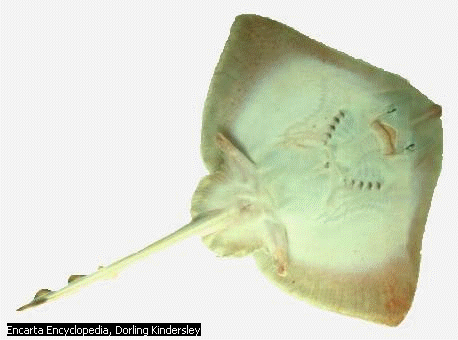 Ray
is the common name for any of about 425 species of cartilaginous
fishes found in almost all seas. Rays have broad, flattened bodies,
with eyes located on the upper, dark colored surface of the body and
with mouth and gills located on the lower, light colored surface. The
pectoral fins are extremely well developed and extend from the tail
to the sides of the head. The pelvic fins are relatively small, and
the anal fin is absent, the tail region being reduced to a slender,
whip-like organ that the ray uses as a rudder. The huge pectoral fins
serve to move the fish through the water at a slow pace. Many rays,
such as the stingrays and electric rays, have developed protective
devices for defense against enemies. Rays have small mouths
containing blunt teeth, adapted for crushing the shells of the
mollusks and crustaceans on which they feed. The creatures inhabit
the ocean bottom, often burying themselves in the sand when not in
search of food. They can change colors to camouflage themselves. Some
species lay eggs; in most species the young are born live.
Ray
is the common name for any of about 425 species of cartilaginous
fishes found in almost all seas. Rays have broad, flattened bodies,
with eyes located on the upper, dark colored surface of the body and
with mouth and gills located on the lower, light colored surface. The
pectoral fins are extremely well developed and extend from the tail
to the sides of the head. The pelvic fins are relatively small, and
the anal fin is absent, the tail region being reduced to a slender,
whip-like organ that the ray uses as a rudder. The huge pectoral fins
serve to move the fish through the water at a slow pace. Many rays,
such as the stingrays and electric rays, have developed protective
devices for defense against enemies. Rays have small mouths
containing blunt teeth, adapted for crushing the shells of the
mollusks and crustaceans on which they feed. The creatures inhabit
the ocean bottom, often burying themselves in the sand when not in
search of food. They can change colors to camouflage themselves. Some
species lay eggs; in most species the young are born live.
Rays vary
in size from a few centimeters to more than 6 meters (more than 20
feet) in width. The largest rays are known as devilfish, sea bats, or
mantas; they attain a weight of more than 1360 kilograms (more than
3000 pounds).
The ray
order includes the guitar fishes; the sawfishes; the skates; the
stingrays; the devilfishes; the electric rays and the eagle rays.
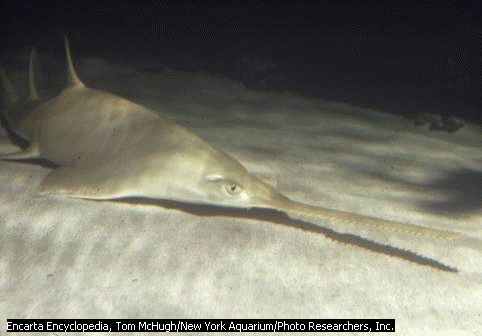 Sawfish
Sawfish
Sawfish are
rays that differ from most rays in being less broadly flattened.
Sawfishes bring forth live young, rather than laying eggs. Their
chief distinction is an elongate snout, which attains a length of
almost 2 meters (almost 6 feet); the snout is studded with strong
toothlike projections. The sawfish uses this structure as a weapon
with which to slash disturbers and also obtain food. Adult sawfishes
attain a total length, including saw, of from 3 to 6 meters (10 to 20
feet). They inhabit the shallow regions of tropical seas, being
especially abundant off tropical America and Africa. The common
sawfish is found from the Gulf of Mexico southward.
Skate
Skates are
flat-bodied rays found in warm and temperate seas, including the
coastal waters of the United States. The flesh of the European, or
gray, skate, which attains a weight of 45 kilograms (100 pounds), is
extensively eaten in Europe; skate flesh is not common in the
American diet. The smallest and commonest of the skates found along
the eastern coast of North America is the little, or hedgehog, skate,
which attains a length of less than 60 centimeters (less than 2 feet)
and is densely spotted with black on its upper surface. The big
skate, found off the coast of California, is the largest of the
American skates, attaining a length of about 2 meters (about 7 feet);
the egg cases deposited by the female are almost 30 centimeters
(almost 1 feet) long.
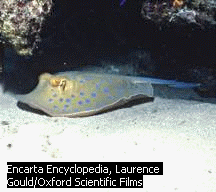 Stingray
Stingray
Stingrays
have broad, flattened pectoral fins that give them an almost diamond
shape; in some species the fins are more than 1.5 meters (5 feet)
wide. The long, finless, whiplike tail has one or more large, sharp,
sometimes barbed spines at its base that are associated with poison
glands and can inflict severe wounds-stingrays are, in fact, the most
common cause of severe fish stings. They are ovoviviparous-that is,
the female carries eggs that hatch at the time of birth.
Devilfish
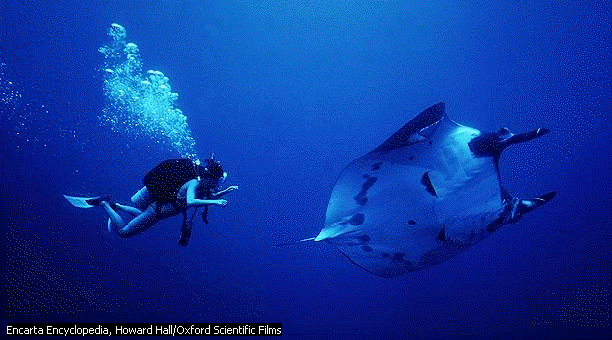 Devilfish
is the name applied to several marine animals, primarily to any
large species of ray (also called manta). Devilfishes are found in
temperate and tropical waters near continents and island groups of
all oceans. These cartilaginous fishes, also called devil rays and
sea bats, have greatly extended, wing-like pectoral fins. The
largest, the Atlantic manta, can measure 7 meters (23 feet) from tip
to tip of these fins. Like the devil ray, the Atlantic manta is
characterized by a pair of forward-pointing lobes on each side of the
head, with a presumed resemblance to a devil's horns. These lobes are
used to guide plankton and small crustaceans into the fish's mouth as
it cruises near the surface; dense gill rakers extract the plankton.
The fish is harmless to humans, but its thrashing when caught can be dangerous.
Devilfish
is the name applied to several marine animals, primarily to any
large species of ray (also called manta). Devilfishes are found in
temperate and tropical waters near continents and island groups of
all oceans. These cartilaginous fishes, also called devil rays and
sea bats, have greatly extended, wing-like pectoral fins. The
largest, the Atlantic manta, can measure 7 meters (23 feet) from tip
to tip of these fins. Like the devil ray, the Atlantic manta is
characterized by a pair of forward-pointing lobes on each side of the
head, with a presumed resemblance to a devil's horns. These lobes are
used to guide plankton and small crustaceans into the fish's mouth as
it cruises near the surface; dense gill rakers extract the plankton.
The fish is harmless to humans, but its thrashing when caught can be dangerous.
A torpedo generates electricity from columns of stacked, platelike
cells called electroplates that are organized into many small blocks
of muscle on either side of its head. Nerves branching throughout the
electric organs initiate the charge, which intensifies as it passes
through the column. The torpedo wraps its pectoral fins around its
prey, disabling it with a 200-volt shock.
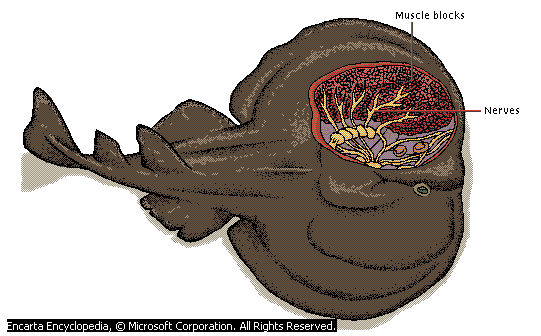 Torpedo
Torpedo
The
torpedo, also called electric ray, include several related rays that
inhabit warm seas and often are of large size, reaching a length of
up to 1.8 meters (up to 6 feet). The Atlantic torpedo, found on both
sides of the Atlantic, is said to attain a weight of about 90
kilograms (about 200 pounds). These rays have a broad, flat body with
a comparatively slender tail and are of interest because of the
electrical powers that they possess. An electric organ consisting of
plate-like cells derived from muscle tissue is found in each pectoral
fin. These organs emit pulsed discharges that combine to deliver a
shock of up to 200 Volts for about 1 second. The shocks enable
torpedoes to stun faster-swimming fishes and also serve as a defense
against predators. Once discharged, the rays require a rest period
before they become charged again. The organs adapted for this purpose
consist of groups of highly compact nerve endings.
Eagle Ray
The eagle
ray family includes the cownose ray, the duck-billed ray, and the bat
ray. The eagle ray may weigh as much as 360 kilograms (800 pounds).
The fleshy pad around the front of its head distinguishes it from the
other rays. The eagle ray's large, expanded, pectoral fins join its
head to form a broad disk, and its flat teeth are adapted for feeding
on shellfish. Near the base of its long, thin tail is a serrated
spine that can inflict a severe wound. The eagle ray's young are born alive.
Scientific classification
Rays belong
to the class Chondrichthyes.
Stingrays
make up the family Dasyatidae. The freshwater stingrays of
South America make up the family Potamotrygonidae. Sawfish
make up the family Pristidae of the order Rajiformes.
The common sawfish is classified as Pristis pectinata. Skates
make up the family Rajidae of the order Rajiformes. The
European, or gray, skate is classified as Raja batis, the
little, or hedgehog, skate as Raja erinacea, the smooth, or
barn-door, skate as Raja laevis, and the big skate as Raja binoculata.
Devilfishes belong to the family Mobulidae. The Atlantic
manta is classified as Manta birostris. The devil ray is
classified as Mobula hypostoma. Torpedoes, or Electric rays,
make up the family Torpedinidae of the order Rajiformes.
The Atlantic torpedo is classified as Torpedo nobiliana. The
eagle ray is a member of the family Myliobatidae, class Chondrichthyes.
It is classified in the genus Myliobatis.
Microsoft
® Encarta ® Encyclopedia 2002. © 1993-2001 Microsoft
Corporation. All rights reserved.
 Ray
is the common name for any of about 425 species of cartilaginous
fishes found in almost all seas. Rays have broad, flattened bodies,
with eyes located on the upper, dark colored surface of the body and
with mouth and gills located on the lower, light colored surface. The
pectoral fins are extremely well developed and extend from the tail
to the sides of the head. The pelvic fins are relatively small, and
the anal fin is absent, the tail region being reduced to a slender,
whip-like organ that the ray uses as a rudder. The huge pectoral fins
serve to move the fish through the water at a slow pace. Many rays,
such as the stingrays and electric rays, have developed protective
devices for defense against enemies. Rays have small mouths
containing blunt teeth, adapted for crushing the shells of the
mollusks and crustaceans on which they feed. The creatures inhabit
the ocean bottom, often burying themselves in the sand when not in
search of food. They can change colors to camouflage themselves. Some
species lay eggs; in most species the young are born live.
Ray
is the common name for any of about 425 species of cartilaginous
fishes found in almost all seas. Rays have broad, flattened bodies,
with eyes located on the upper, dark colored surface of the body and
with mouth and gills located on the lower, light colored surface. The
pectoral fins are extremely well developed and extend from the tail
to the sides of the head. The pelvic fins are relatively small, and
the anal fin is absent, the tail region being reduced to a slender,
whip-like organ that the ray uses as a rudder. The huge pectoral fins
serve to move the fish through the water at a slow pace. Many rays,
such as the stingrays and electric rays, have developed protective
devices for defense against enemies. Rays have small mouths
containing blunt teeth, adapted for crushing the shells of the
mollusks and crustaceans on which they feed. The creatures inhabit
the ocean bottom, often burying themselves in the sand when not in
search of food. They can change colors to camouflage themselves. Some
species lay eggs; in most species the young are born live. Sawfish
Sawfish Stingray
Stingray Devilfish
is the name applied to several marine animals, primarily to any
large species of ray (also called manta). Devilfishes are found in
temperate and tropical waters near continents and island groups of
all oceans. These cartilaginous fishes, also called devil rays and
sea bats, have greatly extended, wing-like pectoral fins. The
largest, the Atlantic manta, can measure 7 meters (23 feet) from tip
to tip of these fins. Like the devil ray, the Atlantic manta is
characterized by a pair of forward-pointing lobes on each side of the
head, with a presumed resemblance to a devil's horns. These lobes are
used to guide plankton and small crustaceans into the fish's mouth as
it cruises near the surface; dense gill rakers extract the plankton.
The fish is harmless to humans, but its thrashing when caught can be dangerous.
Devilfish
is the name applied to several marine animals, primarily to any
large species of ray (also called manta). Devilfishes are found in
temperate and tropical waters near continents and island groups of
all oceans. These cartilaginous fishes, also called devil rays and
sea bats, have greatly extended, wing-like pectoral fins. The
largest, the Atlantic manta, can measure 7 meters (23 feet) from tip
to tip of these fins. Like the devil ray, the Atlantic manta is
characterized by a pair of forward-pointing lobes on each side of the
head, with a presumed resemblance to a devil's horns. These lobes are
used to guide plankton and small crustaceans into the fish's mouth as
it cruises near the surface; dense gill rakers extract the plankton.
The fish is harmless to humans, but its thrashing when caught can be dangerous. Torpedo
Torpedo